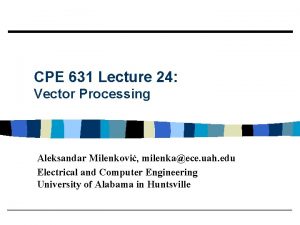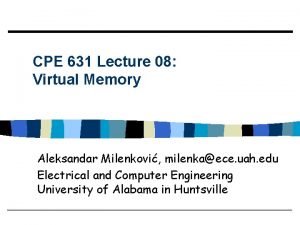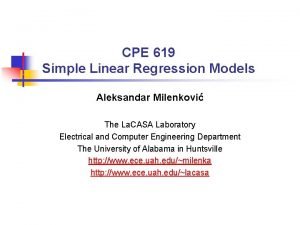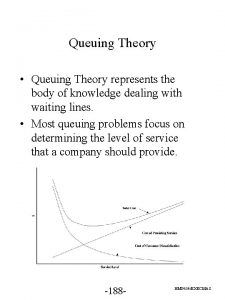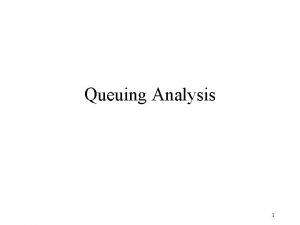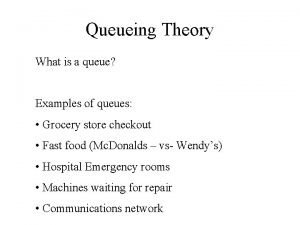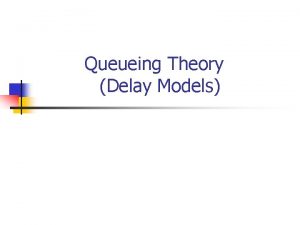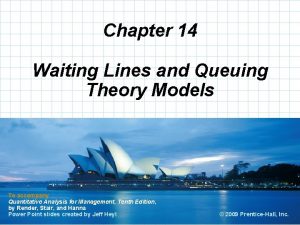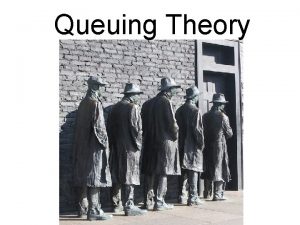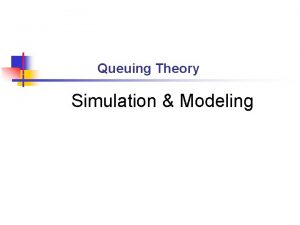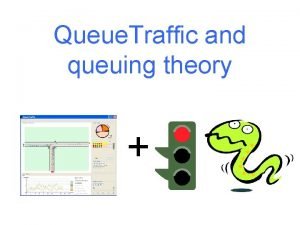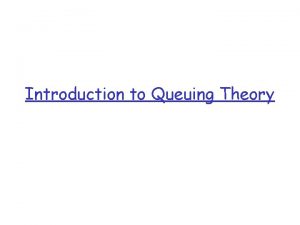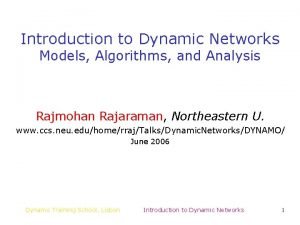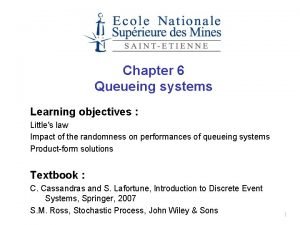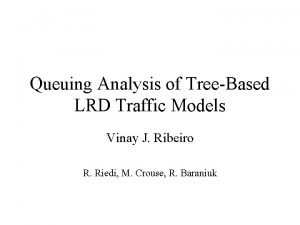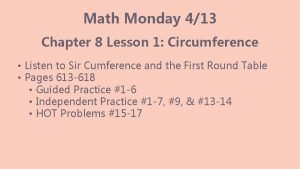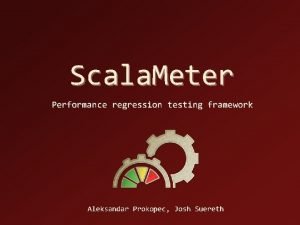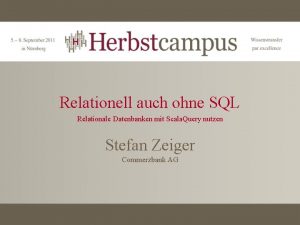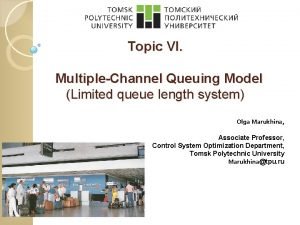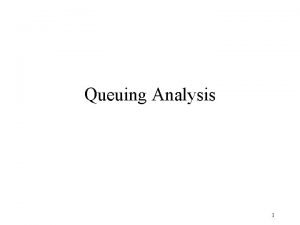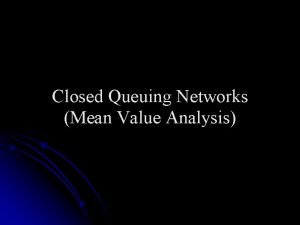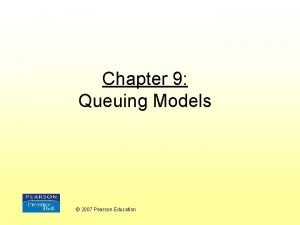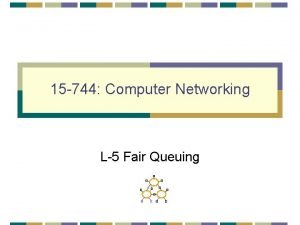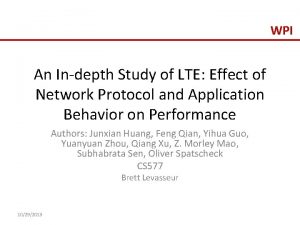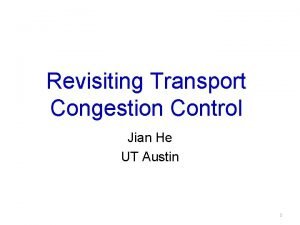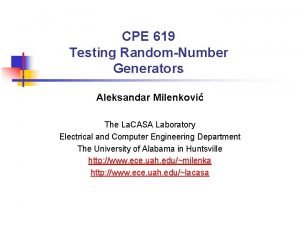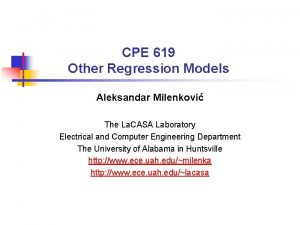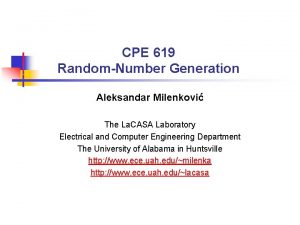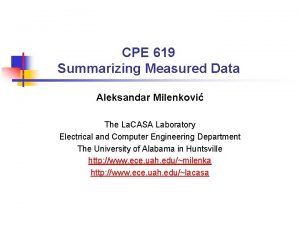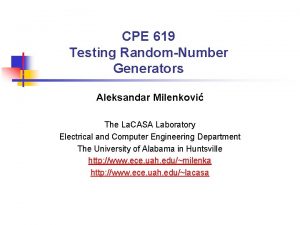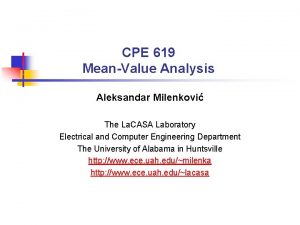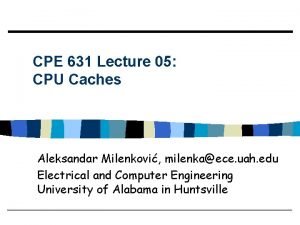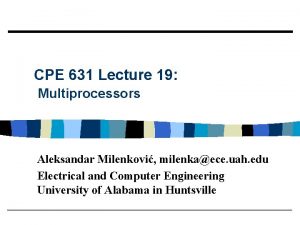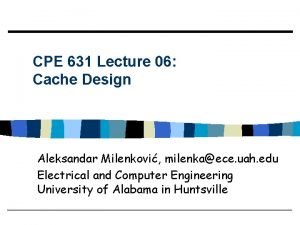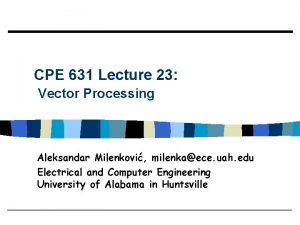CPE 619 Introduction to Queuing Theory Aleksandar Milenkovi










![Group Arrivals/Service n n Bulk arrivals/service M[x]: x represents the group size G[x]: a Group Arrivals/Service n n Bulk arrivals/service M[x]: x represents the group size G[x]: a](https://slidetodoc.com/presentation_image_h/ee35905d22597defe5542a43baef9f8f/image-11.jpg)











































- Slides: 54

CPE 619 Introduction to Queuing Theory Aleksandar Milenković The La. CASA Laboratory Electrical and Computer Engineering Department The University of Alabama in Huntsville http: //www. ece. uah. edu/~milenka http: //www. ece. uah. edu/~lacasa

Overview n n Queueing Notation Rules for All Queues Little's Law Types of Stochastic Processes 2

Queueing Models: What Will You Learn? n n n n What are various types of queues? What is meant by an M/M/m/B/K queue? How to obtain response time, queue lengths, and server utilizations? How to represent a system using a network of several queues? How to analyze simple queueing networks? How to obtain bounds on the system performance using queueing models? How to obtain variance and other statistics on system performance? How to subdivide a large queueing network model and solve it? 3

Basic Components of a Queue 1. Arrival process 5. Customer Population 6. Service discipline 2. Service time distribution 4. Waiting positions 3. Number of servers Example: students at a typical computer terminal room with a number of terminals. If all terminals are busy, the arriving students wait in a queue. 4

Kendall Notation A/S/m/B/K/SD n n n A: Arrival process S: Service time distribution m: Number of servers B: Number of buffers (system capacity) K: Population size, and SD: Service discipline 5

Arrival Process n n Arrival times: Interarrival times: tj form a sequence of Independent and Identically Distributed (IID) random variables The most common arrival process: Poisson arrivals n n Inter-arrival times are exponential + IID Poisson arrivals Notation: n n M = Memoryless = Poisson E = Erlang H = Hyper-exponential G = General Results valid for all distributions 6

Service Time Distribution n n Time each student spends at the terminal Service times are IID Distribution: M, E, H, or G Device = Service center = Queue Buffer = Waiting positions 7

Service Disciplines n n n First-Come-First-Served (FCFS) Last-Come-First-Served (LCFS) Last-Come-First-Served with Preempt and Resume (LCFS-PR) Round-Robin (RR) with a fixed quantum. Small Quantum Processor Sharing (PS) Infinite Server: (IS) = fixed delay Shortest Processing Time first (SPT) Shortest Remaining Processing Time first (SRPT) Shortest Expected Processing Time first (SEPT) Shortest Expected Remaining Processing Time first (SERPT). Biggest-In-First-Served (BIFS) Loudest-Voice-First-Served (LVFS) 8

Common Distributions n n n M: Exponential Ek: Erlang with parameter k Hk: Hyper-exponential with parameter k D: Deterministic constant G: General All Memoryless: n n Expected time to the next arrival is always 1/l regardless of the time since the last arrival Remembering the past history does not help 9

Example: M/M/3/20/1500/FCFS n n n n Time between successive arrivals is exponentially distributed Service times are exponentially distributed Three servers 20 Buffers = 3 service + 17 waiting After 20, all arriving jobs are lost Total of 1500 jobs that can be serviced Service discipline is first-come-first-served Defaults: n n n (Only the first 3 parameters are sufficient to indicate the type) Infinite buffer capacity Infinite population size FCFS service discipline G/G/1 = G/G/1/1/1/FCFS 10
![Group ArrivalsService n n Bulk arrivalsservice Mx x represents the group size Gx a Group Arrivals/Service n n Bulk arrivals/service M[x]: x represents the group size G[x]: a](https://slidetodoc.com/presentation_image_h/ee35905d22597defe5542a43baef9f8f/image-11.jpg)
Group Arrivals/Service n n Bulk arrivals/service M[x]: x represents the group size G[x]: a bulk arrival or service process with general inter-group times Examples: n n M[x]/M/1 : Single server queue with bulk Poisson arrivals and exponential service times M/G[x]/m: Poisson arrival process, bulk service with general service time distribution, and m servers 11

Key Variables 1 2 l m nq Previous Arrival Time ns Begin End Service Arrival t n m w s r 12

Key Variables (cont’d) n n n n t = Inter-arrival time = time between two successive arrivals l = Mean arrival rate = 1/E[t] May be a function of the state of the system, e. g. , number of jobs already in the system s = Service time per job = Mean service rate per server = 1/E[s] Total service rate for m servers is m n = Number of jobs in the system. This is also called queue length Note: Queue length includes jobs currently receiving service as well as those waiting in the queue 13

Key Variables (cont’d) n n nq = Number of jobs waiting ns = Number of jobs receiving service r = Response time or the time in the system = time waiting + time receiving service w = Waiting time = Time between arrival and beginning of service 14

Rules for All Queues Rules: The following apply to G/G/m queues 1. Stability Condition: l < m Finite-population and the finite-buffer systems are always stable 2. Number in System versus Number in Queue: n = n q+ n s Notice that n, nq, and ns are random variables. E[n]=E[nq]+E[ns] If the service rate is independent of the number in the queue, Cov(nq, ns) = 0 15

Rules for All Queues (cont’d) 3. Number versus Time: If jobs are not lost due to insufficient buffers, Mean number of jobs in the system = Arrival rate Mean response time 4. Similarly, Mean number of jobs in the queue = Arrival rate Mean waiting time This is known as Little's law. 5. Time in System versus Time in Queue r=w+s r, w, and s are random variables E[r] = E[w] + E[s] 16

Rules for All Queues (cont’d) 6. If the service rate is independent of the number of jobs in the queue, Cov(w, s)=0 17

Little's Law n n Mean number in the system = Arrival rate Mean response time This relationship applies to all systems or parts of systems in which the number of jobs entering the system is equal to those completing service Named after Little (1961) Based on a black-box view of the system: Arrivals n Black Box Departures In systems in which some jobs are lost due to finite buffers, the law can be applied to the part of the system consisting of the waiting and serving positions 18

Proof of Little's Law 4 Arrival Job 3 number 2 1 Departure 4 Number 3 in 2 System 1 12345678 Time n n n 12345678 Time If T is large, arrivals = departures = N 4 Arrival rate = Total arrivals/Total time= N/T Time 3 Hatched areas = total time spent inside the in 2 system by all jobs = J System Mean time in the system= J/N 1 Mean Number in the system = J/T = (N/T) (J/N) = Arrival rate Mean time in the system 1 2 3 Job number 19

Application of Little's Law Arrivals n Applying to just the waiting facility of a service center n n Departures Mean number in the queue = Arrival rate Mean waiting time Similarly, for those currently receiving the service, we have: n Mean number in service = Arrival rate Mean service time 20

Example 30. 3 n n A monitor on a disk server showed that the average time to satisfy an I/O request was 100 milliseconds. The I/O rate was about 100 requests per second. What was the mean number of requests at the disk server? Using Little's law: Mean number in the disk server = Arrival rate Response time = 100 (requests/second) (0. 1 seconds) = 10 requests 21

Stochastic Processes n n n Process: Function of time Stochastic Process: Random variables, which are functions of time Example 1: n n n(t) = number of jobs at the CPU of a computer system Take several identical systems and observe n(t) The number n(t) is a random variable Can find the probability distribution functions for n(t) at each possible value of t Example 2: n w(t) = waiting time in a queue 22

Types of Stochastic Processes n n Discrete or Continuous State Processes Markov Processes Birth-death Processes Poisson Processes 23

Discrete/Continuous State Processes n n n Discrete = Finite or Countable Number of jobs in a system n(t) = 0, 1, 2, . . n(t) is a discrete state process The waiting time w(t) is a continuous state process Stochastic Chain: discrete state stochastic process 24

Markov Processes n n n Future states are independent of the past and depend only on the present Named after A. A. Markov who defined analyzed them in 1907 Markov Chain: discrete state Markov process Markov It is not necessary to know how long the process has been in the current state State time has a memoryless (exponential) distribution M/M/m queues can be modeled using Markov processes The time spent by a job in such a queue is a Markov process and the number of jobs in the queue is a Markov chain 25

Birth-Death Processes l 0 0 1 1 n n n l 1 l 2 … 2 2 lj-1 3 j-1 lj j j lj+1 j+2 The discrete space Markov processes in which the transitions are restricted to neighboring states Process in state n can change only to state n+1 or n-1. Example: the number of jobs in a queue with a single server and individual arrivals (not bulk arrivals) 26

Poisson Processes n n Interarrival time s = IID and exponential number of arrivals n over a given interval (t, t+x) has a Poisson distribution arrival = Poisson process or Poisson stream Properties: n n 1. Merging: 2. Splitting: If the probability of a job going to ith substream is pi, each substream is also Poisson with a mean rate of pi l 27

Poisson Processes (cont’d) n 3. If the arrivals to a single server with exponential service time are Poisson with mean rate l, the departures are also Poisson with the same rate l provided l < m 28

Poisson Process (cont’d) n 4. If the arrivals to a service facility with m service centers are Poisson with a mean rate l, the departures also constitute a Poisson stream with the same rate l, provided l < åi mi. Here, the servers are assumed to have exponentially distributed service times. 29

Relationship Among Stochastic Processes 30

Summary n n Kendall Notation: A/S/m/B/k/SD, M/M/1 Number in system, queue, waiting, service Service rate, arrival rate, response time, waiting time, service time Little’s Law: Mean number in system = Arrival rate X Mean time spent in the system Processes: Markov Memoryless, Birth-death Adjacent states Poisson IID and exponential inter-arrival 31

Analysis of A Single Queue

Overview n n n Birth Death Processes M/M/1 Queue M/M/m/B Queue with Finite Buffers Results for other Queueing systems 33

Birth-Death Processes n n n Jobs arrive one at a time (and not as a batch) State = Number of jobs n in the system Arrival of a new job changes the state to n+1 birth Departure of a job changes the system state to n-1 death State-transition diagram: l 0 0 l 1 1 1 l 2 … 2 2 lj-1 3 j-1 lj j j lj+1 j+2 34

Birth-Death Processes (cont’d) n When the system is in state n, it has n jobs in it. n n n The new arrivals take place at a rate ln The service rate is n We assume that both the inter-arrival times and service times are exponentially distributed 35

Theorem: State Probability n n The steady-state probability pn of a birth-death process being in state n is given by: Here, p 0 is the probability of being in the zero state 36

Proof n Suppose the system is in state j at time t. There are j jobs in the system. In the next time interval of a very small duration Dt, the system can move to state j-1 or j+1 with the following probabilities: 37

Proof (cont’d) n n n If there are no arrivals or departures, the system will stay in state j and, thus: Dt = small zero probability of two events (two arrivals, two departure, or a arrival and a departure) occurring during this interval pj(t) = probability of being in state j at time t 38

Proof (cont’d) n n The jth equation above can be written as follows: Under steady state, pj(t) approaches a fixed value pj, that is: 39

Proof (cont’d) n Substituting these in the jth equation, we get: n The solution to this set of equations is: 40

Proof (cont’d) n The sum of all probabilities must be equal to one: 41

M/M/1 Queue n n n M/M/1 queue is the most commonly used type of queue Used to model single processor systems or to model individual devices in a computer system Assumes that the interarrival times and the service times are exponentially distributed and there is only one server No buffer or population size limitations and the service discipline is FCFS Need to know only the mean arrival rate l and the mean service rate State = number of jobs in the system l 0 l 1 l … 2 l J-1 l J+1 42

Results for M/M/1 Queue n Birth-death processes with n Probability of n jobs in the system: 43

Results for M/M/1 Queue (cont’d) n n The quantity l/m is called traffic intensity and is usually denoted by symbol r. Thus: n is geometrically distributed. Utilization of the server = Probability of having one or more jobs in the system: 44

Results for M/M/1 Queue (cont’d) n Mean number of jobs in the system: n Variance of the number of jobs in the system: 45

Results for M/M/1 Queue (cont’d) n n Probability of n or more jobs in the system: Mean response time (using the Little's law): Mean number in the system = Arrival rate × Mean response time That is: 46

Results for M/M/1 Queue (cont’d) n n Cumulative distribution function of the response time: The response time is exponentially distributed. q-percentile of the response time 47

Results for M/M/1 Queue (cont’d) n n n Cumulative distribution function of the waiting time: This is a truncated exponential distribution. Its qpercentile is given by: The above formula applies only if q is greater than 100(1 -r). All lower percentiles are zero. 48

Results for M/M/1 Queue (cont’d) n n Mean number of jobs in the queue: Idle there are no jobs in the system The time interval between two successive idle intervals All results for M/M/1 queues including some for the busy period are summarized in Box 31. 1 in the book. 49

Example 31. 2 n n n On a network gateway, measurements show that the packets arrive at a mean rate of 125 packets per second (pps) and the gateway takes about two milliseconds to forward them. Using an M/M/1 model, analyze the gateway. What is the probability of buffer overflow if the gateway had only 13 buffers? How many buffers do we need to keep packet loss below one packet per million? Arrival rate l = 125 pps Service rate = 1/. 002 = 500 pps Gateway Utilization r = l/m = 0. 25 Probability of n packets in the gateway = (1 -r)rn = 0. 75(0. 25)n) 50

Example 31. 2 (cont’d) n Mean Number of packets in the gateway = (r/(1 -r) = 0. 25/0. 75 = 0. 33) Mean time spent in the gateway = ((1/m)/(1 -r)= (1/500)/(1 -0. 25) = 2. 66 milliseconds Probability of buffer overflow n To limit the probability of loss to less than 10 -6: n n We need about ten buffers. 51

Example 31. 2 (cont’d) n The last two results about buffer overflow are approximate. Strictly speaking, the gateway should actually be modeled as a finite buffer M/M/1/B queue. However, since the utilization is low and the number of buffers is far above the mean queue length, the results obtained are a close approximation. 52

Summary n n n Birth-death processes: Compute probability of having n jobs in the system M/M/1 Queue: Load-independent => Arrivals and service do not depend upon the number in the system ln= l, mn=m Traffic Intensity: r = l/ m Mean Number of Jobs in the system = r/(1 -r) Mean Response Time = (1/m)/(1 -r) 53

M/M/m Queue 59
 Milenkovi
Milenkovi Popcvm
Popcvm Milenkovi
Milenkovi Milenkovi
Milenkovi Milenkovi
Milenkovi Milenkovi
Milenkovi Queueing theory
Queueing theory Queuing theory formula
Queuing theory formula Queuing theory formula
Queuing theory formula Queueing theory
Queueing theory Mm1 queue
Mm1 queue Constant service time model
Constant service time model Queuing theory calculator
Queuing theory calculator Waiting line model
Waiting line model Queuing theory simulation
Queuing theory simulation Queuing theory
Queuing theory Queuing theory definition
Queuing theory definition Queuing theory
Queuing theory Littles law
Littles law Queuing theory formula
Queuing theory formula Articulo 619
Articulo 619 Xkcd recursion
Xkcd recursion Xkcd insurance
Xkcd insurance Swe 619 gmu
Swe 619 gmu Lesson 2 reteach area of circles answer key
Lesson 2 reteach area of circles answer key Swe 619
Swe 619 Swe 619
Swe 619 Swe 619 gmu
Swe 619 gmu Sf 619
Sf 619 Idea part b section 619
Idea part b section 619 632 rounded to the nearest ten
632 rounded to the nearest ten Scala meter
Scala meter Aleksandar kupusinac
Aleksandar kupusinac Objektno programiranje
Objektno programiranje Aleksandar plamenac
Aleksandar plamenac Aleksandar rakicevic fon
Aleksandar rakicevic fon Aleksandar kuzmanovic flashback
Aleksandar kuzmanovic flashback Aleksandar tatalovic
Aleksandar tatalovic Aleksandar nikcevic
Aleksandar nikcevic Aleksandar baucal
Aleksandar baucal Abx aleksandar settings
Abx aleksandar settings Kartelj matf
Kartelj matf Vjenčanje europe i azije
Vjenčanje europe i azije Aleksandar prokopec
Aleksandar prokopec Aleksandar.krizo
Aleksandar.krizo Aleksandar stefanovic sorbonne
Aleksandar stefanovic sorbonne Primjeri franšize u hrvatskoj
Primjeri franšize u hrvatskoj Peritoneoskopija
Peritoneoskopija Multi channel queuing model
Multi channel queuing model Queuing analysis examples
Queuing analysis examples Closed queuing network
Closed queuing network Queuing models
Queuing models Fair queuing example
Fair queuing example Queuing delay
Queuing delay Rtt
Rtt

